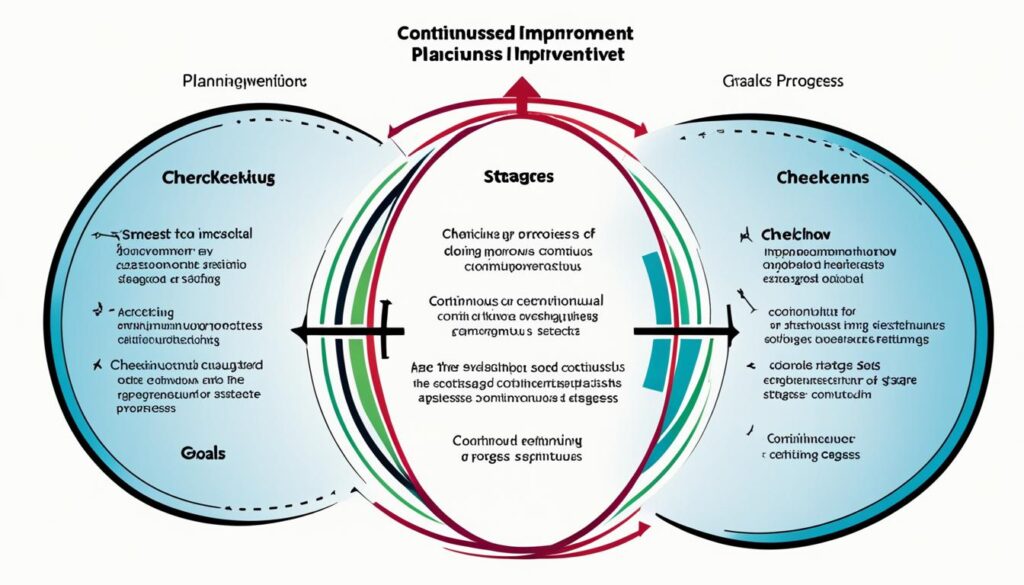Continuous improvement is a journey that involves four key steps. These are: observation, analysis, planning, and action. It helps us reach our full potential. It’s about getting better, both personally and within our organizations. Coaching is very important here. It gives us the support and guidance we need.
It’s important to understand that continuous improvement doesn’t mean making big changes all at once. Instead, it’s about small steps you take over time. These small changes can really add up. Plus, being able to adapt to change is a key part. This can help you become stronger and more resilient. By using continuous improvement strategies, you can see big results. This approach can be a blueprint for improving the workplace in a positive way.
Key Takeaways:
- Continuous improvement involves observation, analysis, planning, and action.
- Coaching offers the support and guidance needed during the improvement process.
- Small changes over time can lead to significant improvements.
- Continuous improvement strategies can form a pathway to positive workplace changes.
The Four Stages of Continuous Improvement
The PDCA cycle has four parts: Plan, Do, Check, and Act. Each part is important for making small improvements over time. They help reach big success goals in the long run.
Plan:
First, in the Plan stage, we look for chances to get better. We build a plan to fix these areas. This step includes looking at what we’re doing now, finding data, and setting improvement goals. The plan acts as a guideline for the next steps in the PDCA cycle.
Do:
Then, the Do stage starts. We begin to make the planned changes. We test these changes on a small scale first. We do this to see how well they work and if they need any tweaks before going big.
Check:
In the Check stage, we see if the changes worked. We collect and look at data. Then, we compare the results with our goals to know if we made the progress we wanted. This step helps us spot problems, if any, and learn from our efforts.
Act:
The last part is the Act stage. If the changes were good, we use them everywhere. But, if things still need fixing, we go back to the start. This keeps the cycle going for continuous improvement.
Small changes and always trying to improve are at the heart of the process. By using the PDCA cycle, organizations can make real growth. This method helps stay on track and keep getting better, leading to lasting success.

Methods for Continuous Improvement
Continuous improvement doesn’t fit one mold. Many methods work, each with unique aims and targets.
The Lean methodology targets efficiency through waste reduction and streamlined work. It finds and cuts out non-essential steps. This way, companies can work better. Kanban is about making work visible and splitting it into doable tasks. It helps teams watch how well they’re doing and adjust things anytime.
Six Sigma shines at finding and wiping out process errors using stats, which keeps quality at top levels. Total Quality Management focuses on what customers want. It makes sure a company meets customer needs, fixes any quality problems, and aims for constant betterment. Both put customer joy and continuous progress front and center for company victory.
The Agile methodology favors short, successive progress pairs with quick reviews to birth top-notch software seamlessly. It supports always changing and growing. That leads to quicker results and happier clients.
These approaches offer routes to work better all the time. Whether it focuses on cutting waste, smoothing out operations, perfecting quality, or delighting clients, there’s a method that fits a company’s aims and desires.
FAQ
What is continuous improvement?
Why is coaching important in the continuous improvement process?
What is the PDCA cycle?
How does the PDCA cycle work?
What are the different methods for continuous improvement?
What is the Lean methodology?
How does the Kanban method contribute to continuous improvement?
What is Six Sigma?
What is Total Quality Management?
What is the Agile methodology?
Source Links
- https://blog.kainexus.com/continuous-improvement/culture-of-continuous-improvement/7-surefire-ways-to-promote-continuous-improvement-in-the-workplace
- https://www.betterup.com/blog/continuous-improvement
- https://www.mentimeter.com/blog/great-leadership/how-to-promotes-continuous-improvement-in-the-workplace




